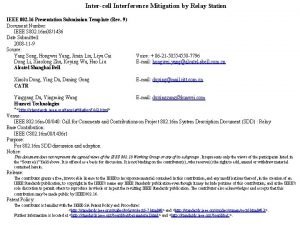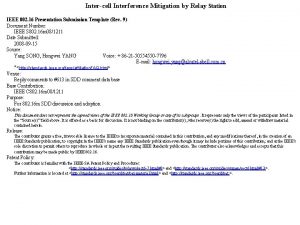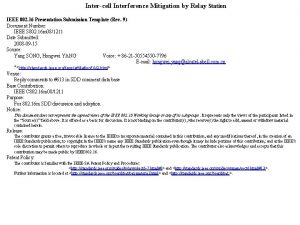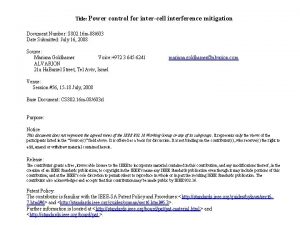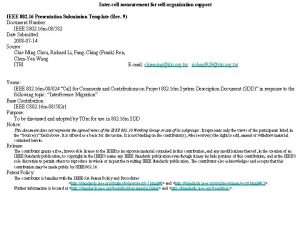Intercell Mitigation for 802 16 m IEEE 802







- Slides: 7

Inter-cell Mitigation for 802. 16 m IEEE 802. 16 Presentation Submission Template (Rev. 9) Document Number: IEEE S 802. 16 m-08/583 Date Submitted: 2008 -07 -14 Source: Chang-Lan Tsai, Ren-Jr Chen, Chung-Lien Ho Yan-Xiu Zheng, Richard Li ITRI Wern-Ho Sheen NCTU/ITRU E-mail: {tsaichangl, richard 929}@itri. org. tw Venue: Call for Contributions of IEEE 802. 16 m_08/024 on the topic of “Interference Mitigation” Base Contribution: IEEE C 802. 16 m-08/583 r 1 Purpose: To be discussed and adopted by TGm for use in 802. 16 m SDD Notice: This document does not represent the agreed views of the IEEE 802. 16 Working Group or any of its subgroups. It represents only the views of the participants listed in the “Source(s)” field above. It is offered as a basis for discussion. It is not binding on the contributor(s), who reserve(s) the right to add, amend or withdraw material contained herein. Release: The contributor grants a free, irrevocable license to the IEEE to incorporate material contained in this contribution, and any modifications thereof, in the creation of an IEEE Standards publication; to copyright in the IEEE’s name any IEEE Standards publication even though it may include portions of this contribution; and at the IEEE’s sole discretion to permit others to reproduce in whole or in part the resulting IEEE Standards publication. The contributor also acknowledges and accepts that this contribution may be made public by IEEE 802. 16. Patent Policy: The contributor is familiar with the IEEE-SA Patent Policy and Procedures: <http: //standards. ieee. org/guides/bylaws/sect 6 -7. html#6> and <http: //standards. ieee. org/guides/opman/sect 6. html#6. 3>. Further information is located at <http: //standards. ieee. org/board/pat-material. html> and <http: //standards. ieee. org/board/pat >.

Frequency Reuse Factor • Frequency reuse 1 – Same frequency is reused by each sector – High spectral efficiency – Large inter-cell interference • Cell edge users can rarely retain connection

Frequency Reuse Factor • Frequency reuse 3 – Same frequency is reuse every 3 sectors – Low spectral efficiency – Low inter-cell interference • Cell edge users have fairly good connection quality

Fractional Frequency Reuse • Different frequency reuse factor in one sector – Sector edge band using frequency reuse 3 • Allocated to the cell edge users – Sector center band using frequency reuse 1 • Allocated to the users in the center of the sector

Soft Fractional Frequency Reuse • To compensate the spectral efficiency loss due to fractional frequency reuse – The reserved band at each sector is allocated for center users with restricted power

Flexible Fractional Frequency Reuse • Semi-static fractional frequency reuse – The ratio of sector center and sector edge bands is adaptive to traffic load, user distribution, etc. Soft frequency reuse 3

Proposed Text 11. x Interference Mitigation 11. x. y Interference suppression by fractional frequency reuse Fractional frequency reuse (FFR) scheme should be supported to improve average and cell-edge user throughput. The ratio of different frequency reuse factor and the corresponding power level are optimized or adjusted adaptively according to the traffic load and user distribution, etc. , to trade of between spectral efficiency and average/cell-edge user throughput enhancement. Coordination between BSs for frequency partition is needed to avoid/suppress inter-cell/sector interference.








